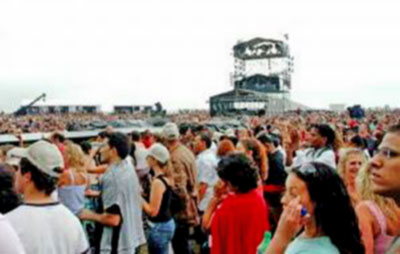|

by Rick Nauert PhD
Senior News Editor
reviewed by John M. Grohol, Psy.D.
February 15, 2008
from
PsychCentral Website
Spanish version

A new research study sheds light on a
behavior that is consistent among many species - that is, making
decisions based upon the actions of others.
Scientists at the University of Leeds believe they may have found
why humans flock like sheep and birds, subconsciously following a
minority of individuals. Researchers discovered that it takes a
minority of just five per cent to influence a crowd’s direction -
and that the other 95 per cent follow without realizing it.
The findings could have major implications for directing the flow of
large crowds, in particular in disaster scenarios, where verbal
communication may be difficult.
“There are many situations where
this information could be used to good effect,” says Professor
Jens Krause of the University’s Faculty of Biological Sciences.
“At one extreme, it could be used to inform emergency planning
strategies and at the other, it could be useful in organizing
pedestrian flow in busy areas.”
Professor Krause, with PhD
student John Dyer, conducted a series of experiments where
groups of people were asked to walk randomly around a large hall.
Within the group, a select few received
more detailed information about where to walk. Participants were not
allowed to communicate with one another but had to stay within arms
length of another person.
The findings show that in all cases, the ‘informed individuals’ were
followed by others in the crowd, forming a self-organizing,
snake-like structure.
“We’ve all been in situations where
we get swept along by the crowd,” says Professor Krause.
“But
what’s interesting about this research is that our participants
ended up making a consensus decision despite the fact that they
weren’t allowed to talk or gesture to one another. In most cases
the participants didn’t realize they were being led by others.”
Other experiments in the study used
groups of different sizes, with different ratios of ‘informed
individuals’.
The research findings show that as the
number of people in a crowd increases, the number of informed
individuals decreases. In large crowds of 200 or more, five per cent
of the group is enough to influence the direction in which it
travels.
The research also looked at different scenarios for the location of
the ‘informed individuals’ to determine whether where they were
located had a bearing on the time it took for the crowd to follow.
“We initially started looking at
consensus decision making in humans because we were interested
in animal migration, particularly birds, where it can be
difficult to identify the leaders of a flock,” says Professor
Krause.
“But it just goes to show that there
are strong parallels between animal grouping behavior and human
crowds.”
The paper relating to this research is
entitled "Consensus
Decision Making in Human Crowds".
|


